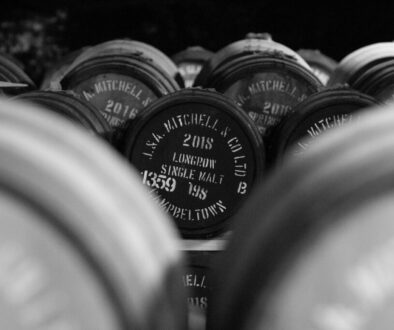The Process of Making Peated Whisky
Let’s keep this as simple as possible, shall we? Peat is used as a fuel source to dry malted barley and halt germination. There we go, that’s it… only of course it isn’t, because peat or lack of it also imbues whisky with specific and distinctive flavours.
The drying of malted barley is the key step in which peat flavours are ‘infused’ into the barley, which will then be fermented and distilled into your cherished whisky.
We still come across customers who are convinced that the water that runs through peat bogs plays the key role in ‘peatiness’. Before distillation you might perhaps get a hint of it but after it’s been run through at least two stills and turned from liquid to gas and back into liquid, the small hint of peatiness from the water would be indiscernible. Instead it is all due to the intense exposure of the malted barley to peat smoke when it is being dried.
PPM (phenol parts per million) levels are what peatiness is measured in. Roughly the bigger the level, the more peat. However while PPM is an accurate count of the phenol chemistry in these tiny kernels of barley it’s still best to use it as more of a guide. Peat reek (the smoke from the peat) must be applied to the whisky making process intensely when kilning. For the best results, you want your barley dried avoiding too much flaming in the kilning process to smoke the barley to whatever level you’re aiming for.
Regarding peat and water, within Scotland itself, peat is extremely important part of potable drinking water. Almost 4% of drinking water in the UK that is stored in reservoirs has come from some form of peatland.

How Much Peat Is Used In Whisky Production?
There has never been a solid formula for this. It takes skill of the Maltster at the kiln to know how much to add to the fire to get the “house style” that any distillery can be aiming for. And that is before you take into consideration the different peats and the varying flavours they can impart.
For example, Islay peat is very different to the peat found on the mainland of Scotland, anywhere in Ireland and everywhere else in the world. Highland/mainland peat is drier and contains more old tree roots and less water. As a result mainland peat has a more BBQ/culinary smoke to it. Peat sourced from Islands and coastal areas has more contact with water and is more likely to be built up of seaweed and decaying mosses, and it is those organics that produce some of the distinctive Islay peat notes (TCP hit anyone?).
The rough numbers for peat cultivation are varied. What is agreed on however is that only 1 mm will renew per year.
Some peat is still hand dug throughout the world, but most is machine cut. After a sod line is cut the peat has partially dried, taking its moisture levels down to 70%.
Of all the peat that is extracted in the UK, as little as 1% is used for Scotch whisky production. Islay peat is even less than that. Around 5% of the UK’s peat is extracted every year (144,887 hectares or 14.49 tonnes per square meter) from the land.
There have been numerous incentives from countries and distilleries to help put a limit to how much peatland is being used. Lagavulin themselves have committed to restoring twenty-eight full rugby fields worth of peatland. The Scotch Whisky Association has also launched a plan to cut horticultural peat out by 2030. That will indeed cause some stirring among lovers of whisky that smells as if it’s soaked in salt water, pickle brine and cigar smoke for several days.

Where Does Peated Whisky Usually Come From?
Peat for whisky making is mostly sourced at the north and west coasts of Scotland. But the use of peat in the process of these whiskies isn’t an accident. In remote Scotland coal and gas weren’t something which as easy to get hold of. The peat of Scotland was used to cook, build and eventually to dry barley for whisky. If you’re looking for something bold and peated to have a good time with:
Isle of Islay: Lagavulin, Laphroaig, Ardbeg, Bunnahabhain (Moine), Caol Ila, Bruichladdich (Port Charlotte & Octomore), Bowmore, Kilchoman, Port Ellen and eventually Ardnahoe.
Isle of Skye: Talisker and Torabhaig
Isle of Raasay: Raasay
Isle of Orkney: Highland Park
Isle of Mull: Ledaig (Peated Tobermory)
Isle of Arran: Arran Machrie Moore and eventually The Lagg Distillery.
Campbeltown: Springbank, Longrow, Kilkerran Heavily Peated, Glen Scotia Victoriana.
Lowlands: Ailsa Bay.
Highlands: Clynelish, Brora, Edradour (Ballechin), Ben Nevis, Ardnamurchan,
Speyside: Benriach and Benromach.
Trying any of these side by side will really give you an impact of how different peated whiskies can be.



